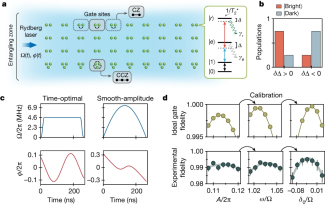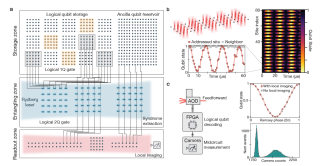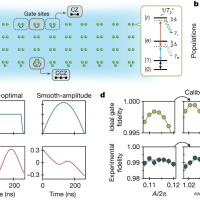News
High-fidelity parallel entangling gates in atom arrays
Recently, neutral-atom arrays have emerged as a promising platform for quantum computing. Atom arrays are highly flexible and reconfigurable, allowing coherent control over hundreds of qubits and connectivity between any qubits in the array. The main outstanding challenge of using atom arrays has been to reduce errors in entangling operations, which rely on highly-excited atomic Rydberg states. In a recent publication, the Lukin group, in close collaboration with the groups of Markus Greiner at Harvard and Vladan Vuletic at MIT, reported the development of two-qubit entangling gates with 99.5% fidelity on up to 60 atoms in parallel, which greatly improves upon the previous state-of-the-art and exceeds quantum-error-correction thresholds. Their method uses fast, single-pulse gates based on optimal control, atomic dark states to reduce scattering, and improvements to Rydberg excitation and atom cooling. Fidelity was measured using several methods based on repeated gate applications, and physical error sources were characterized to lay out a path to future improvements. Ultimately, the group generalized their method to design entangling gates with higher numbers of qubits, which they demonstrated with low-error three-qubit gates. By enabling low-error operation in a scalable, highly-connected system, these advances lay the groundwork for large-scale implementation of quantum algorithms, error-corrected circuits, and digital simulations.
Read the full paper at https://doi.org/10.1038/s41586-023-06481-y.

Figure 1. Parallel implementation of high-fidelity entangling gates on a neutral-atom quantum computer.
Logical quantum processor based on reconfigurable atom arrays
Error suppression is a central challenge in useful quantum computing, requiring quantum error correction to allow large-scale processing. In a recent paper, the Lukin group, in close collaboration with the groups of Markus Greiner at Harvard and Vladan Vuletic at MIT, realized a programmable quantum processor based on encoded logical qubits. Using efficient logical-level control in reconfigurable atom arrays, their system combines up to 280 physical qubits with high two-qubit gate fidelities. This system further allows arbitrary connectivity, fully programmable qubit rotations, and midcircuit readout and feedforward. The processor uses a zoned architecture and multiple types of encodings, which allowed the group to demonstrate: improvement of two-qubit logical gates by scaling surface code distance from d = 3 to d = 7; preparation of color code qubits with break-even fidelities; and fault-tolerant creation of logical GHZ states. The team further demonstrated operation of up to 40 color code qubits, as well as feedforward entanglement teleportation. Finally, their recent publication used three-dimensional code blocks to perform complex sampling circuits with up to 48 logical qubits, which were entangled with hypercube connectivity with 228 logical two-qubit gates and 48 logical CCZ gates. This logical encoding outperforms physical qubit fidelities at both cross-entropy benchmarking and quantum simulations of fast scrambling. These results herald the advent of early error-corrected quantum computation and chart a path toward large-scale logical processors.
Read the full paper, published last week at: https://www.nature.com/articles/s41586-023-06927-3

Figure 2. A schematic of a programmable logical processor based on reconfigurable atom arrays, showing how logical qubits can be efficiently controlled and entangled within different zones to perform complex error-corrected algorithms.
